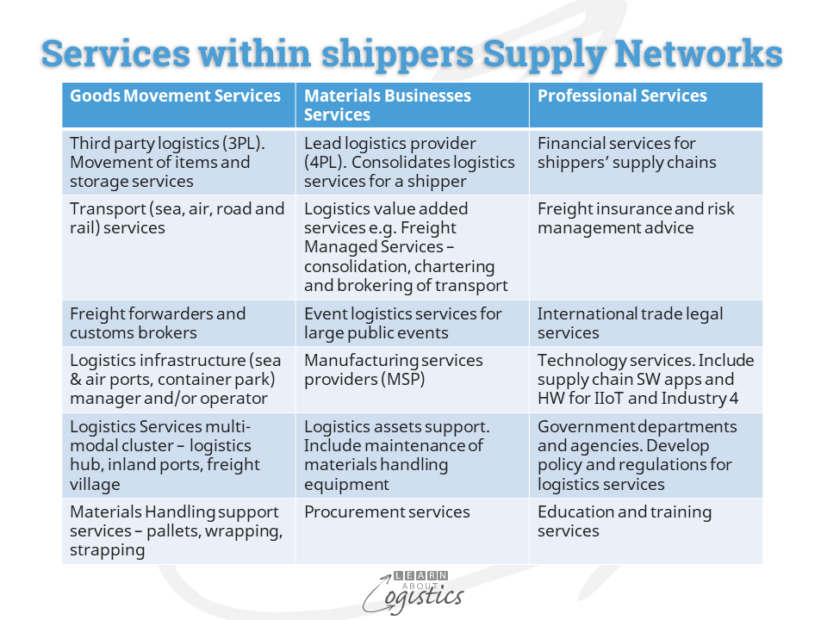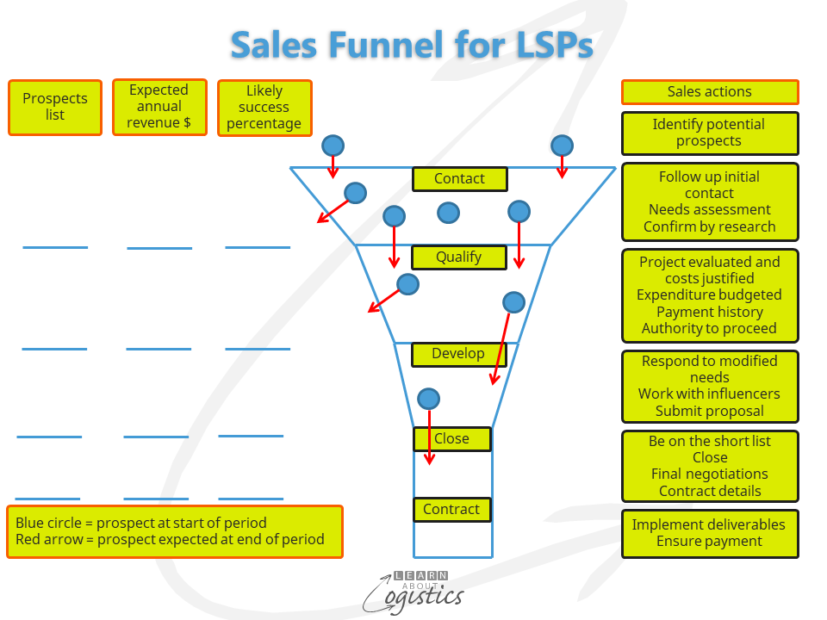Logistics services that are sold
Sales of Logistics Services do not just happen. They come about through individuals and teams winning contracts that provide services; those which shippers are not equipped to undertake or are unwilling to provide the investment.
Logistics Services address a wide array of offerings available to shippers. The enterprises providing these services are generically called Logistics Service Providers (LSPs).

The table identifies, within three broad categories, the Logistics services available:
- Goods Movement Services are provided to support Logistics Operations. Items pass from the client’s supplier, through the service provider to the client’s customer without a change in form, or with only minimal value adding
- Within this group of services, the most common form of LSP is the third party logistics (3PL) services provider. A 3PL is an additional party to a contract between a supplier (the seller or shipper) and their customer (the buyer). The 3PL is contracted to provide warehousing and/or distribution services and to reduce customer satisfaction risk
- Materials Business Services support the supply chain processes within a client shipper’s organisation
- Professional Services are corporate aligned supply chain functions that a shipper has elected to outsource
Some LSPs offer multiple services across the categories, while others specialise. Both can sell:
- A ‘once-off’ service for which continual repeat business is required or
- Long term contracts for an LSP’s services
Planning the sales process
A LSP’s expectations of the relationship with a prospect will range from high strategic importance through to low attention (but with effective process and systems support). A LSP will therefore invest different levels of resources to gain a new client that will be profitable. Management at an LSP must therefore be selective in commencing a sales relationship with prospects; also, as the process is advanced towards an order. If there is a good chance of coming second in the sale process, why spend the money?
The LSP five step ‘sales funnel’ diagram below provides an overview of the sales situation for a representative. This identifies the progress in gaining sales and therefore the resources required to close the sale,

Contact: A discussion has occurred with a person in the prospect organisation. They ares responsible for or involved in a possible use for the logistics services. At the contact meeting, the aim for the representative is to complete a needs assessment by understanding:
- Prospect’s supply chain objectives
- Current and future logistics problems and needs. The LSP representative’s industry knowledge can assist to identify challenges and patterns
- Time-frame for a solution to be operational
- Internal resources available at the prospect for implementation
- Role of the contact person in the sale of the service(s)
- The decision maker and recommender for logistics investments
- Time-frame for investment decisions
- Approximate budget for this type of project or ongoing service
- Agreement from the prospect contact person for follow–up action
Following the initial contact, the LSP representative is able to recommend a ‘go or no go’ decision.
Qualify: The objective from subsequent meetings and presentations is to identify whether there is a desire at the prospect to buy logistics services from the LSP. What is the likelihood of doing business with the prospect? The LSP representative is able to:
- Describe the opportunity – $ value of service offerings from the LSP
- Fit the LSP service offering to the opportunity
- Understand the prospect’s decision process and timetable
- Identify key personnel in the decision process at the prospect. The ‘coach’ who can provide inside knowledge, supporters of the LSP’s service offering and potential blockers of a proposal
- Identify that funds are or will be available for the potential contract
- Confirm that the prospect will pay invoices within the required period
Develop: The prospect has accepted that a solution to their problem is required and that the LSP’s solution will work:
- Demonstrate how the LSP’s proposed service offering provides superior benefits to those from competitors
- Identify issues with the prospect’s internal processes and objections to the LSP’s proposed service offering
- Options to overcome the issues have been discussed, possible solutions accepted and prioritised
- Proposal is submitted for the ‘best fit’ service(s) and cost (based on a best estimate of the ‘cost to serve’ at the prospect’s business)
Close: There are many approaches to closing a sale. Although people want to make their own buying decisions, an LSP must help a prospect to make the decision. The objective is for management at the prospect to move the LSP’s Proposal from the short list, to be recommended for approval.
- The LSP’s Proposal is recommended by the designated person, for approval by the final authority
- The prospect has committed resources in support of the LSP’s proposed solution
- Final contract is negotiated and signed
Contract: The deliverables are implemented ‘on time and on budget’ and the new client pays their accounts ‘in full and on time’.
- Client accepts to be a reference account
Selling logistics services
To close a proposed contract for services require knowledgeable representatives who understands their own organisation’s business. As important is their knowledge of a prospect’s supply chains and their influence on the business. This requires the representative to focus on three elements in the sales process of consultative selling:
- Understand the prospect’s business: Prospects are not generic businesses. Just selling the LSPs offering based on features and benefits will not achieve a sale. Understand three logistics aspects about a prospect:
- The extent of Uncertainty (complexity, variability and constraints) in their supply network
- Their use of logistics assets
- Logistics transactions activity levels
- Listen more and sell less: Allow the prospect to discuss their supply chains and challenges. The LSP’s representative (with their knowledge and skills concerning logistics) can add value by proposing alternative approaches for consideration. Use open-ended questions
- Build trust and be honest: As logistics services are not a product to be touched, a prospect is buying on the basis of trust in the LSP (which includes a reduction in risk). This includes the LSP identifying what they cannot do well (but propose ways to overcome the challenge) and avoiding unsubstantiated claims of ‘benefits’
This more structured approach for selling logistics services enables LSPs to be more client focused. They can apply resources to prospects which have needs that fit the LSP’s capabilities, so the chance of a successful sale is improved. This approach can also be of help to the buyers (shippers), by helping them to better identify the LSPs with a professional approach to sales.

